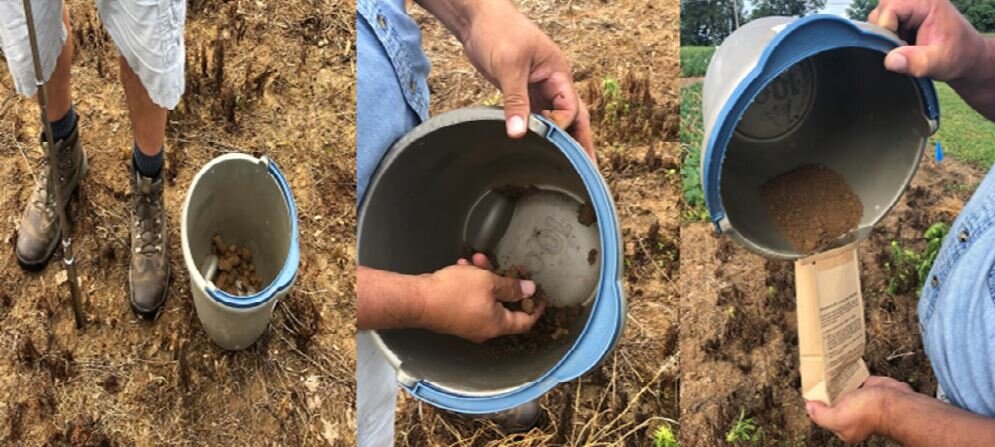Phosphorus and Potassium for Winter Wheat, and What About Nitrogen?
Edwin Ritchey, John Grove, and Josh McGrath
Department of Plant and Soil Sciences
Fertilizer applications can influence the overall yield and profit of crop production systems. Phosphorus (P), potassium (K), and lime additions for winter wheat production should be based on a good soil sampling and testing protocol. A soil test is recommended every two years or less, depending on the crop rotation and individual field knowledge. Soil samples should be tested with chemical procedures suited (via correlation and calibration re-search) to the production area’s soil, crop and environmental conditions. Finally, sample collection timing, usually spring or fall, is not as important as always being consistent in the timing of soil sampling for an individual field. Consistent soil sample timing permits looking at trends over time. This approach allows for slight fertility adjustments to be made, if needed, that are specific to that field.
Follow these steps to ensure a proper soil sample is collected. First, the sample should fully represent the field/field area of interest. Randomly collect 10-20 soil cores from an area no larger than 20 acres, and that large of an area only if relatively homogeneous – use smaller areas for fields that are more heterogeneous. Collect separate samples from areas that are expected to have higher or lower pH or nutrient levels than most of the field. One or two soil cores that are much higher or lower than the field average can skew test results and resulting lime/fertilizer rate recommendations. Place soil cores in a clean plastic bucket, hand crumble and mix, and then transfer the required amount to the soil sample bag or box for transport to the laboratory (Figure 1).
Figure 1. Collecting a soil sample in a plastic bucket; crumbling and mixing; and transferring the sample to a proper soil sample bag for submission to the laboratory.
Sampling depth can have a large influence on soil test results and fertilizer recommendations (Table 1). Proper soil sampling depth is 4 inches for no-till fields and 6 inches or to the depth of primary tillage for tilled fields. Long-term NT fields usually exhibit nutrient stratification due surficial nutrient applications and no soil mixing. The greatest nutrient concentrations are found at the soil surface and decrease with depth. When the wrong sample depth is used, results can come back higher or lower than those from the correct sampling depth. For example, when a too-shallow sample is collected the nutrient concentration will be higher than expected, resulting in lower than needed fertilizer application. The opposite is true if the sampling depth is too deep (Table 1).
Another consideration when planting wheat this year is fall nitrogen (N) management. Most years, the residual N is adequate for fall wheat growth and early tillering. The exceptions are when corn yields are high and/or the growing season has experienced above normal precipitation, both of which occurred over a large part of Kentucky in 2020. While soil testing is highly recommended and economically advantageous in guiding P, K and lime additions, soil testing’s value for N recommendations is generally less unless a different soil sampling protocol is followed. For a detailed discussion on soil sampling to guide fall N application for wheat production in Kentucky, please see the previous Wheat Science Newsletter article titled “Soil Nitrogen and Fall Wheat N Nutrition” on August 27, 2019.
Fall is an ideal time to adjust soil pH and apply P and K fertilizer following corn harvest, prior to wheat establishment. The soil is usually drier in fall than spring, better supporting fertilizer and lime applicator traffic and reducing the potential for traffic induced soil compaction. Timely soil sampling after corn harvest is key to making fertilizer and/or lime applications prior to winter wheat planting. Further, if P is needed, the N contained in a P fertilizer like DAP (18-46-0) or MAP (10-52-0) will be well utilized by the crop if N is needed at wheat establishment. Each 100 lb of DAP and MAP contain 18 and 10 lb of N, respectively, N usually lost with fall P applications made in the absence of a winter cash or cover crop.
Add the appropriate amount of P and K fertilizer according to the intended crop rotation. Most wheat grown in Kentucky is followed by double-crop soybean. Research at the University of Kentucky determined when the wheat producer intends to use this rotation, they should combine and fall apply P fertilizer according to the wheat recommendation and K fertilizer as recommended for soybean. Fall soil sampling and fertility adjustments prior to wheat establishment work well if adequate time and good weather exist.
Fall soil conditions typically better support field traffic and the winter crop will better use the N associated with many P fertilizers, N that would otherwise be lost when fall-applied to fallow fields. Be sure to take samples that each well represent an area intended for liming/fertilization, and to the appropriate soil sampling depth. Good sampling protocols will optimize lime and fertilizer rate recommendations for the crops to be grown.


